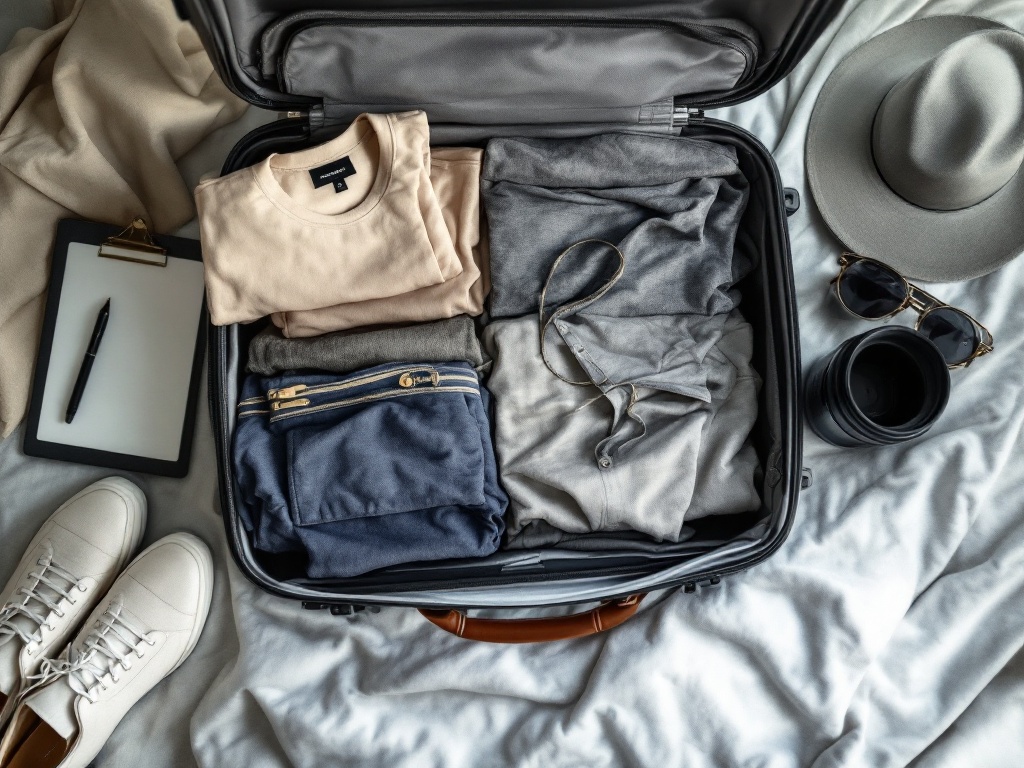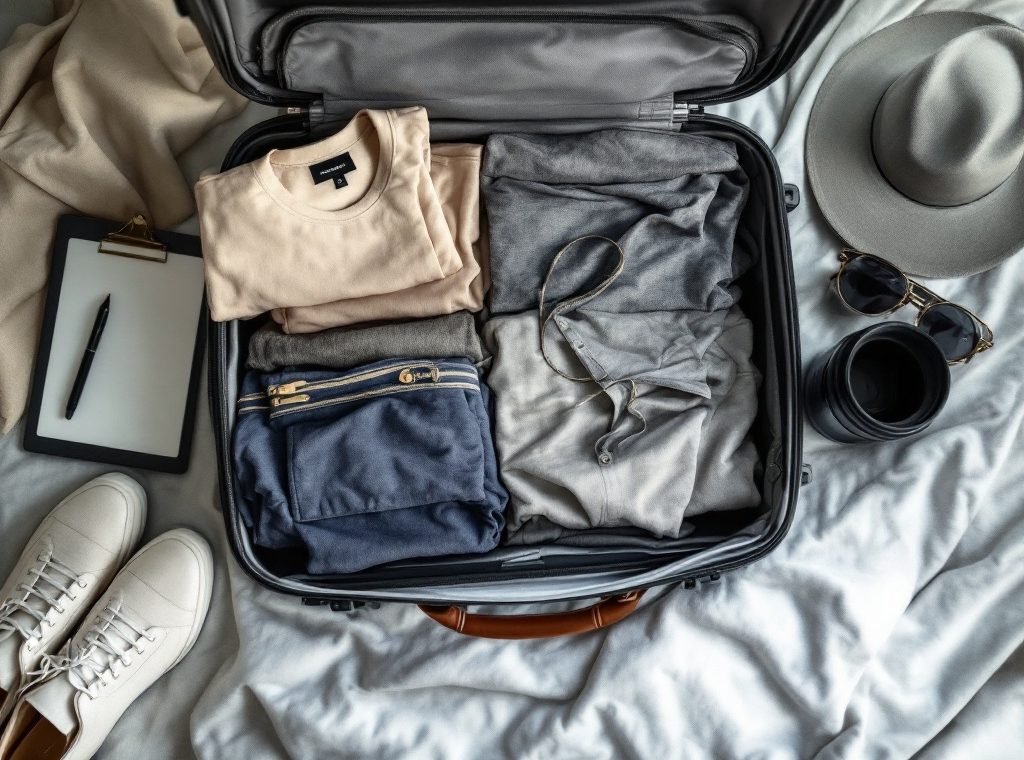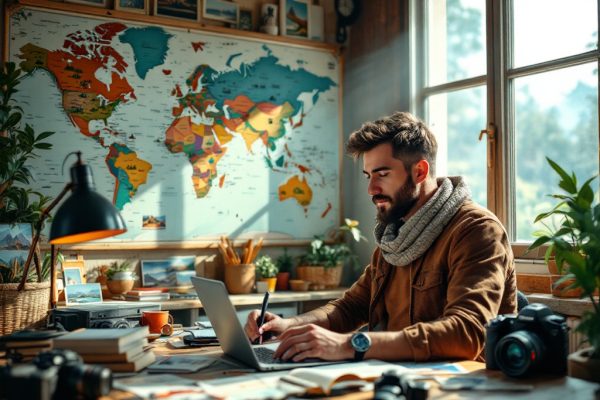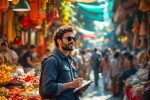What to Wear Traveling as a Journalist
Are you a journalist preparing for your next assignment? Discover how to build a versatile travel wardrobe that transitions seamlessly from formal press conferences to casual interviews. Learn essential packing tips, including choosing comfortable, wrinkle-resistant fabrics and maximizing luggage space with neutral-colored mix-and-match pieces. Explore footwear recommendations for long days on your feet and discover how a capsule wardrobe can simplify your travel preparations. Read on to optimize your packing strategy and focus on what matters most: your story.
Important information

- Journalists need versatile wardrobes adaptable to different assignments and climates, balancing professional and casual attire.
- Prioritize neutral-colored, mix-and-match clothing items made of breathable, quick-drying, wrinkle-resistant fabrics like cotton, linen, merino wool, nylon, or polyester.
- Pack comfortable, supportive shoes suitable for walking and varied situations, such as loafers or sneakers. Consider slip-on shoes for airport travel.
- Utilize packing cubes and compression straps for luggage organization and space maximization. A portable charger, first-aid kit, and necessary adaptors are also essential.
- Research the destination’s culture and dress codes to ensure appropriate attire. Comfort and practicality are key for long reporting days.
Creating a Versatile Travel Wardrobe for Journalists
A journalist’s wardrobe needs to be adaptable, working across a range of settings. This ensures they’re always appropriately dressed, from formal events to casual interviews. Building such a wardrobe requires careful consideration of assignments and work environments. For instance, a war correspondent’s needs differ drastically from a fashion reporter’s. Climate also plays a vital role; arctic expeditions demand different attire than tropical postings. Ultimately, a versatile wardrobe allows journalists to look professional, stay comfortable, and concentrate on their work.
Understanding Dress Codes and Flexibility
A journalist’s wardrobe needs to be adaptable, accommodating both formal events that call for professional attire and more casual settings. This flexibility ensures they’re always dressed appropriately, meeting the diverse demands of their work. For example, a suit is essential for court appearances, while a community event might allow for a more relaxed look. Practicality is also key: journalists must be comfortable and prepared for any situation.
Choosing Between Formal and Casual Attire
Journalistic attire varies considerably depending on several factors, including the nature of their beat, the intended audience, and individual preferences. While some reporters, particularly in traditional settings, wear formal attire such as navy suits and starched white shirts, others enjoy a more relaxed dress code.
Essential Travel Clothing for Journalists
Packing for reporting assignments requires a strategic approach to clothing choices. Prioritize versatile pieces suitable for a range of situations. A combination of formal and casual attire allows you to project both professionalism and adaptability. Pack lightweight layers, including a waterproof jacket. Comfortable shoes are essential for long days on the go. Opting for neutral colors maximizes mix-and-match possibilities, saving valuable luggage space. Breathable, quick-drying, and wrinkle-resistant fabrics offer comfort and convenience. Don’t forget essential accessories like a hat and scarf. Researching your destination’s culture and dress codes is crucial. Comfort and practicality are paramount for long reporting days.
Clothing
- Versatile pieces suitable for diverse situations,
- blend of formal and casual attire,
- lightweight layers, including a waterproof jacket.
Other
- Comfortable shoes,
- neutral colors for mix-and-match possibilities,
- breathable, quick-drying, wrinkle-resistant fabrics,
- accessories like a hat and scarf.
Remember to research your destination’s culture and dress codes. Comfort and practicality are essential for long reporting days.
Opting for Versatile Clothing Items
A journalist’s wardrobe needs to be as adaptable as they are, seamlessly transitioning from formal events to casual interviews. Versatile pieces are essential, maximizing options while minimizing luggage space.
Neutral Colors
Neutral colors for shirts, pants, and dresses offer the greatest flexibility, easily dressed up or down with the right accessories. A simple necklace, for instance, can instantly elevate a casual outfit.
Fabric Choice
Fabric choice is crucial. Durable, wrinkle-resistant materials like nylon or merino wool pack well and require minimal care, perfect for journalists on the go.
Finally, a lightweight jacket or blazer adds warmth and a touch of formality, ideal for impromptu meetings. A versatile wardrobe is a journalist’s best friend.
Utilizing Neutral Palettes and Matching Sets
Neutral colors like black, white, navy, beige, and gray simplify wardrobe choices by making mixing and matching effortless. Matching sets further streamline the process, offering a polished look while minimizing decision fatigue. This is particularly helpful for journalists who frequently pack light and need to dress quickly. For instance, a navy blazer and matching trousers create a professional ensemble, yet each piece can also stand alone. The blazer pairs well with jeans, while the trousers can be styled with a simple white tee. Furthermore, neutrals provide a timeless foundation for bolder accessories. A colorful scarf or statement jewelry adds personality without clashing with the base outfit.
Selecting Comfortable Airport Outfits
Choose breathable fabrics like cotton or linen for a comfortable airport experience.
Wear loose-fitting options such as joggers or leggings to promote better circulation and ease of movement, especially during long flights.
Layer with a cardigan or lightweight jacket to adapt to fluctuating airport temperatures.
Wear supportive slip-on shoes for easy security checks and comfortable terminal navigation.
Practical Outfit Selection for Travel
Layering is essential for journalists. Adaptable options like lightweight jackets, cardigans, or sweaters allow for comfortable adjustments in fluctuating weather conditions and diverse environments. Breathable fabrics, such as cotton, linen, or merino wool, further enhance comfort, especially in warmer climates, by promoting airflow and regulating body temperature.
Travel can be demanding on clothing, so quick-drying fabrics like nylon or polyester are beneficial. These materials minimize the need for ironing and help journalists maintain a presentable appearance while constantly on the move. Comfortable and practical footwear is also crucial. Given that journalists often spend long hours on their feet, supportive shoes, such as loafers or comfortable sneakers, are essential for various situations.
Recommended Fabrics for Layering:
- Cotton: a natural fiber known for its breathability and softness.
- Linen: a lightweight and breathable fabric ideal for warmer climates.
- Merino wool: a natural fiber that regulates body temperature and resists odors.
- Nylon: a quick-drying and durable synthetic fabric.
- Polyester: a wrinkle-resistant and easy-to-care-for synthetic fabric.
Footwear Recommendations:
- Loafers: offer a balance of comfort and style for various occasions.
- Comfortable sneakers: provide essential support for long hours on your feet.
Layering Pieces and Breathable Fabrics
For comfortable travel, layering is essential. Pack lightweight items like jackets, cardigans, or scarves to easily adapt to temperature changes.
Breathable fabrics such as cotton, linen, or merino wool allow air circulation and prevent overheating, ensuring comfort even in fluctuating climates.
- cotton,
- linen,
- merino wool.
Incorporating Quick-Drying and Wrinkle-Resistant Fabrics
Quick-drying fabrics, like polyester and nylon, are ideal for humid climates. These wrinkle-resistant options keep journalists looking sharp, even while constantly on the go. The minimal ironing requirement is a bonus for busy reporters.
Choosing the Right Footwear: Supportive Shoes and Flat Options
Journalists, constantly on the go, require comfortable footwear. Covering events often involves extensive walking, making practical flats a great choice. Lightweight, breathable sneakers are ideal for such situations. Shoes designed for walking, with proper arch support, are also an excellent option. For less demanding occasions or dressier events, packable ballet flats or loafers offer both comfort and a more polished look.
Packing Tips for Journalists on the Go
A capsule wardrobe is essential for efficient packing, especially for journalists who need to travel light. This small collection of mix-and-match essentials, like neutral-colored shirts, pants, and a jacket, creates a surprising number of outfits while minimizing luggage. It ensures you’re prepared for any situation.
Helpful Luggage Features
- Compression straps maximize space.
- Compartments improve organization.
Essential Packing Tools
- Packing cubes keep clothing wrinkle-free and organized.
- Garment folders are also great for wrinkle-free packing.
For journalists, a portable charger is vital for powering devices. A small first-aid kit and necessary adaptors are also must-haves.
Building a Capsule Wardrobe
A capsule wardrobe simplifies outfit creation by maximizing a few essential pieces. This streamlines packing and ensures versatile ensembles for any event. Journalists, for example, benefit from this approach by selecting neutral-colored, interchangeable items. This offers both flexibility and convenience on the go.
Utilizing Travel Features and Packing Essentials
A journalist’s essential tools go beyond the pen and notepad, encompassing practical gear for comfort, safety, and organization. Versatile, comfortable clothing that maintains a professional look is essential. A portable charger is indispensable for staying connected. A lightweight rain jacket offers crucial protection from the elements. Don’t forget a basic first aid kit for minor emergencies. Durable bags are key for safeguarding equipment. Notebooks or laptops are vital for recording information. Packing cubes can be a game-changer for organization. Rolling your clothes instead of folding maximizes space and packing efficiency.
Clothing and Comfort
- Versatile, comfortable, and professional attire is essential for journalists.
- A lightweight rain jacket provides protection from unexpected weather.
Gear and Safety
- A portable charger ensures you stay connected.
- A basic first aid kit is crucial for minor emergencies.
Equipment and Organization
- Durable bags protect valuable equipment.
- Notebooks or laptops are vital for recording information.
- Packing cubes are excellent for organization.
Packing Tip
Roll your clothes instead of folding them to maximize space and packing efficiency.














